We all feel differently about color, especially when it comes to color at home, but outside, nothing makes a garden glow quite like orange-flowering plants. Here are 13 of our favorite orange-flowering great design plants, each of which is sure to bring sunshine to the garden. Most of these plants prefer full sun in warmer climates, but some wildflowers and annuals will flourish in most regions.
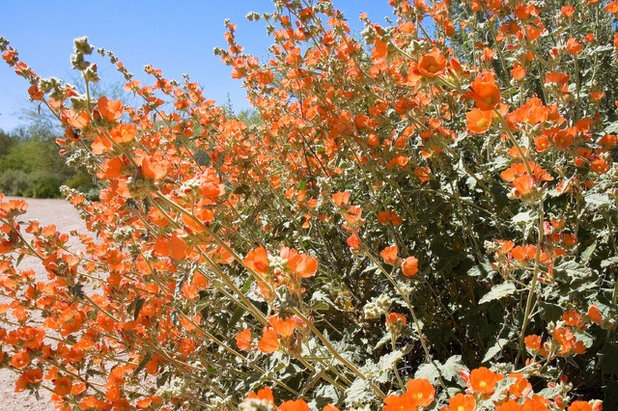
Noelle Johnson Landscape Consulting
Globe Mallow (
Sphaeralcea ambigua)
Each spring a flush of delicate orange — sometimes red, pink or white — flowers resembling mini hollyhocks covers this inconspicuous shrub, which is 3 feet tall and wide. Butterflies flock to its flowers’ nectar, and irregular blooming happens throughout the rest of the year, depending on the climate.
Plant this resilient desert native in well-drained soil in spring or fall from a nursery container or cuttings. It needs little additional care once established; cut it down to 1 foot after flowering every year.
Bloom season: Flowers in spring and intermittently throughout the rest of the year
Cold tolerance: Hardy to -10 degrees Fahrenheit (USDA zones 6 to 9; find your zone)
Origin: Native to arid regions of the American Southwest
Water requirement: Low
Light requirement: Full sun
When to plant: Spring or fall
See how to grow globe mallow
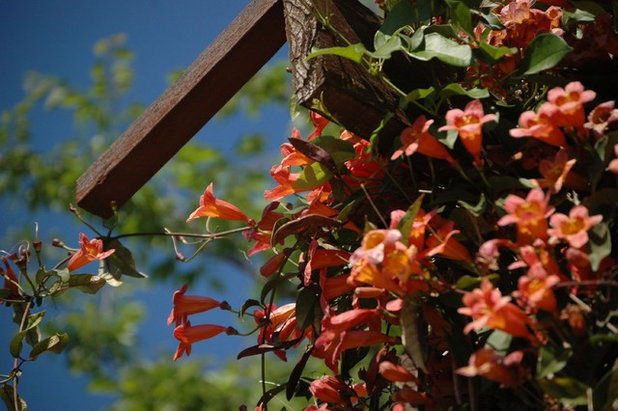
J. Peterson Garden Design
Crossvine (
Bignonia capreolata)
Orange-yellow tubular flowers cover this Southern vine from spring until fall. Sit back and you’ll see bees, butterflies and hummingbirds flying in for some nectar.
Plant it in full sun directly in the ground or in a container near a climbing structure with enough space for it to quickly grow up to 40 feet long.
Bloom season: Spring through fall
Cold tolerance: Hardy to -10 degrees Fahrenheit
(zones 6a to 9b)
Origin: Native to the southeastern U.S.
Water requirement: Consistently moist soil
Light requirement: Sun to partial shade
When to plant: Spring or fall
See how to grow crossvine
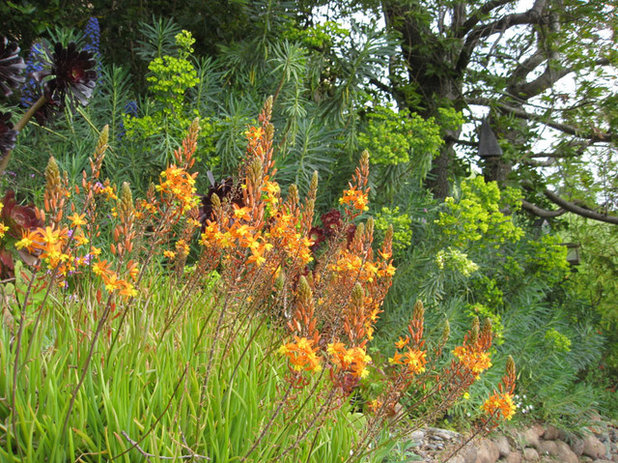
Dig Your Garden Landscape Design
‘Hallmark’ Bulbine(
Bulbine frutescens ‘Hallmark’ syn.
Bulbine caulescens)
Bulbine’s fleshy, clumping foliage mixes up the texture of a succulent garden, and its projecting orange flower spikes add some height and drama. Blooming in spring through fall, and even year-round in some climates, ‘Hallmark’ bulbine brings bees, butterflies and hummingbirds to drought-tolerant gardens.
Plant it in full sun in well-draining soil. Hallmark grows well in containers and reaches about 2 feet tall and wide.
Bloom season: Spring through fall
Cold tolerance: Hardy to 15 degrees Fahrenheit (zones 8 to 10)
Origin: Native to South Africa
Water requirement: Low once established
Light requirement: Full sun to light shade
When to plant: Spring or fall
See how to grow ‘Hallmark’ bulbine
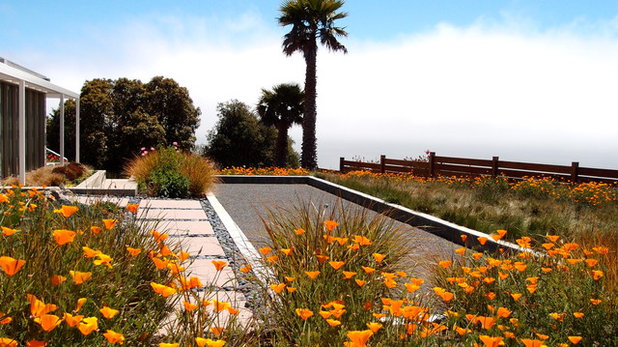
Derviss Design
California Poppy (
Eschscholzia californica)
California’s state flower is as happy to fill out a backyard as it is naturalizing a wild hillside. While they aren’t long-lived flowers, California poppies will quickly fill in a space when planted from seed and thrive in a variety of difficult garden spaces — from barren hillsides to rocky outcroppings.
After they’ve finished blooming, you can pull out the plants or simply let them naturalize and reseed for next year.
Bloom season: Spring through fall, or use it as a summer annual
Cold tolerance: All zones when planted in spring as a spring and summer annual; in mild climates seeds can be sown in fall
Origin: Native from California to parts of southern Washington, Nevada and New Mexico
Water requirement: Light to moderate
Light requirement: Full sun
When to plant: In mild climates you can sow seeds in fall; wait until spring in colder climates.
See how to grow California poppy
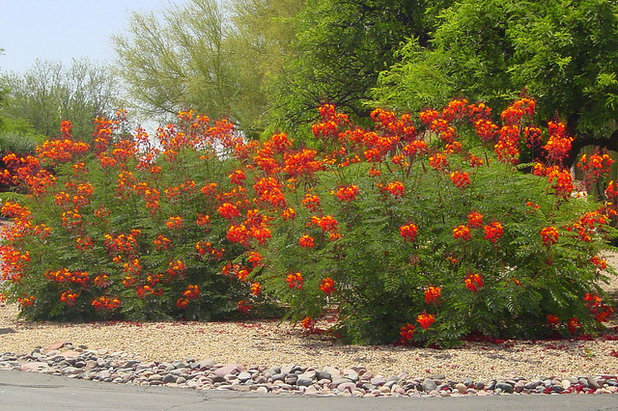
Noelle Johnson Landscape Consulting
Red Bird-of-Paradise(
Caesalpinia pulcherrima)
Red bird-of-paradise’s flowers are downright fiery. Towering flower clusters emerge at the tips of medium green foliage and last through summer as a favored hummingbird nectar source.
Reaching 6 to 10 feet tall, this flowering shrub makes a great screen or informal hedge in hot desert climates. Plant it in full sun in well-drained soil.
Bloom season: Spring through late summer
Cold tolerance: Hardy to 10 degrees Fahrenheit (zones 8 to 11)
Origin: Native to the West Indies and Mexico
Water requirement: Medium
Light requirement: Full sun
When to plant: Spring, summer or fall
See how to grow red bird-of-paradise
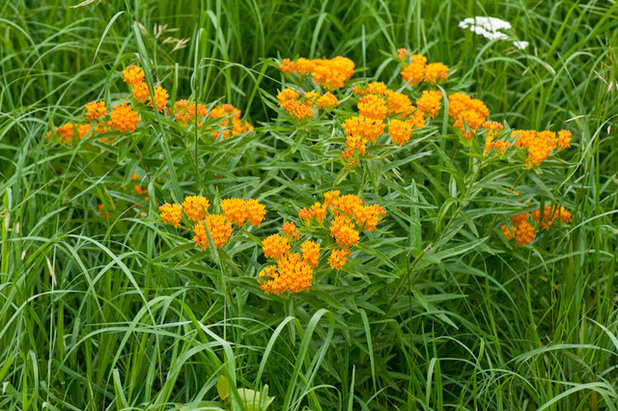
Holm Design & Consulting LLC
Butterfly Milkweed (
Asclepias tuberosa)
Butterfly milkweed might be most well known as a larval host plant for the monarch butterfly, but this prairie perennial also draws bees and butterflies to its nectar and is an important food source when other sources are scarce.
Grow it from seed or a nursery plant in well-drained soil among other medium-size plants. The vibrant orange flowers emerge in late spring lasting into summer, and the plants reach 1 foot to 2 feet tall and 2 to 2½ feet wide.
Bloom season: Late spring
Cold tolerance: Hardy to -40 degrees Fahrenheit (zones 3a to 10b)
Origin: Native to most of North America except for the Canadian Atlantic provinces and northwestern states and provinces
Water requirement: Low; drought tolerant
Light requirement: Full sun
When to plant: Spring or fall
See how to grow butterfly milkweed
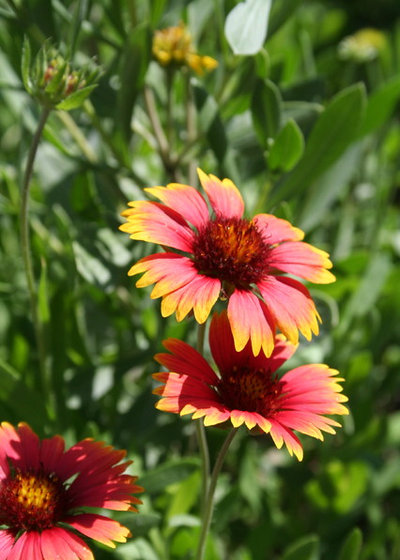 Blanket Flower
Blanket Flower (
Gaillardia x
grandiflora)
Every summer until frost, these colorful flowers blanket gardens coast to coast. Attracting birds, bees and butterflies, they produce a beautiful ground cover that, if allowed to self-seed, will return year after year.
Bloom season: Spring through fall
Cold tolerance: Hardy to -40 degrees Fahrenheit (zones 3 to 10)
Origin: Garden hybrid from North American natives
Water requirement: Drought tolerant once established
Light requirement: Partial shade to full sun
When to plant: Spring or fall
See how to grow blanket flower
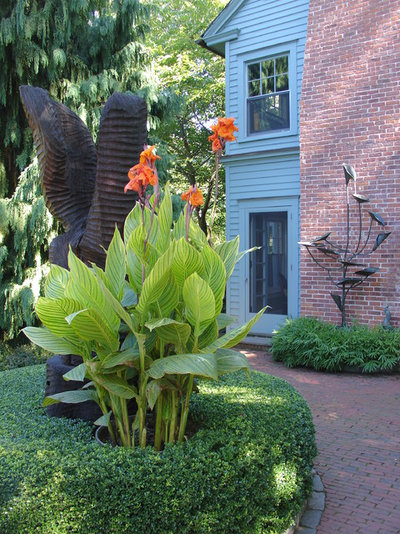
www.KarlGercens.com
Canna Lily (
Canna ‘Pretoria’)
Early summer brings 3-foot-tall orange blooms to the already 3-foot-tall foliage of
Canna ‘Pretoria’. Its bright orange flowers and green and yellow striped leaves make it one of the showiest cannas and also bring a lush, tropical look to gardens. The flowers draw bees, butterflies and hummingbirds.
In warmer climates you can grow this plant in the ground year-round; in colder climates you will want to plant it in a container and move it inside for winter. Or you can dig up the plants and move them inside before the ground freezes for the season. When spring arrives, bring the container or bulbs back out to the garden.
Bloom season: Summer
Cold tolerance: Can be grown anywhere if bulbs are brought inside for winter; winter hardy in zones 7 to 11
Origin: Garden hybrid
Water requirement: Regular
Light requirement: Full sun to partial shade
When to plant: In spring after the threat of frost has passed
See how to grow canna lily
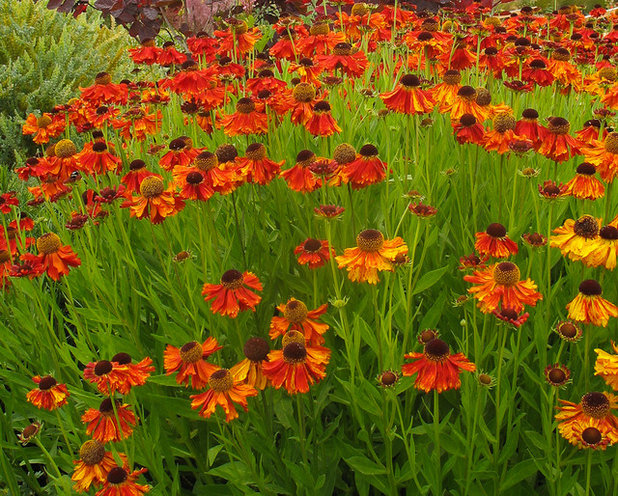
Le jardinet
Sneezeweed (
Helenium ‘Mardi Gras’)
Orange can be used as an accent, but sneezeweed entices you to use it in the whole garden. Vivid orange petals surround a dark brown center, much like the more common black-eyed Susan, or coneflower. In addition to introducing some richer color to the summer garden, these flowers also draw butterflies and bees.
Plant it in spring or fall and watch as these flowers reach 3 feet tall and 3 feet wide. Once they’re mature, you can propagate them by division.
Bloom season: Summer
Cold tolerance: Hardy to -40 degrees Fahrenheit (zones 3 to 9)
Origin: Garden hybrid
Water requirement: Low
Light requirement: Full sun or partial shade
When to plant: Spring or fall
See how to grow sneezeweed
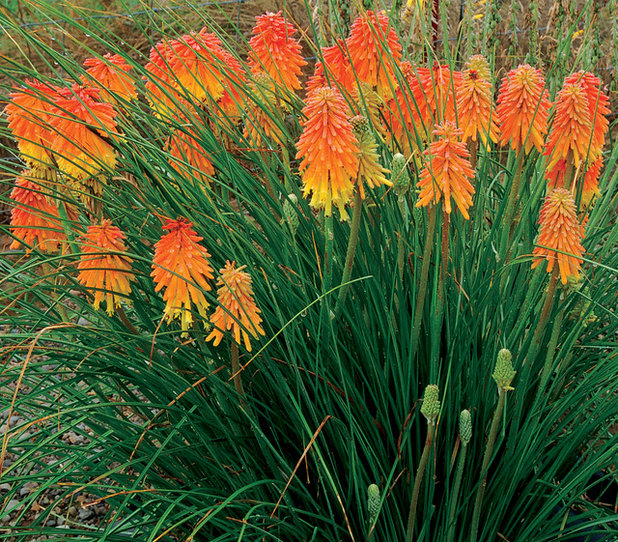
Terra Nova® Nurseries, Inc
Red-Hot Poker (
Kniphofia spp)
Kniphofia hybrids come in colors ranging from yellow to orange to red. Here we see
Kniphofia ‘Ember Glow’ (zones 6 to 9), a clumping and quick-growing red-hot poker that grows to around 16 inches tall and sends out a profuse burst of color from summer into fall. These flowers also attract hummingbirds.
Plant it in a sunny garden spot with rich, well-drained soil.
Bloom season: Summer
Cold tolerance: Hardy to -20 degrees Fahrenheit (zones 5 to 10), depending on species
Origin: Most garden species are from South Africa.
Water requirement: Moderate
Light requirement: Full sun to partial shade
When to plant: Spring or fall
See how to grow red-hot poker
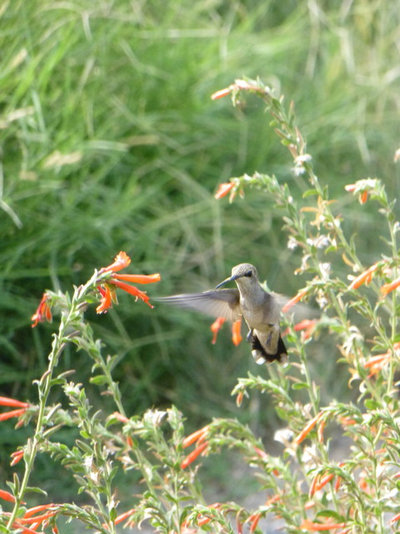
Waterwise Landscapes Incorporated
California Fuchsia(
Zauschneria californica syn.
Epilobium canum)
California fuchsia’s name comes from its resemblance to common fuchsia, but its preference for sunny hillsides and other bright, challenging growing spots distinguishes it.
Its small, tubular flowers are loved by hummingbirds and add a bright splash of color in the late-summer landscape. It grows to 1 foot tall and 4 feet wide and can be used as a tumbler over hillsides, planters or boulders.
Bloom season: Late summer and early fall
Cold tolerance: Hardy to -10 degrees Fahrenheit (zones 6 to 9)
Origin: Native to the western U.S. and northern Mexico
Water requirement: Regular to establish, then light
Light requirement: Full sun
When to plant: Fall or early spring
See how to grow California fuchsia
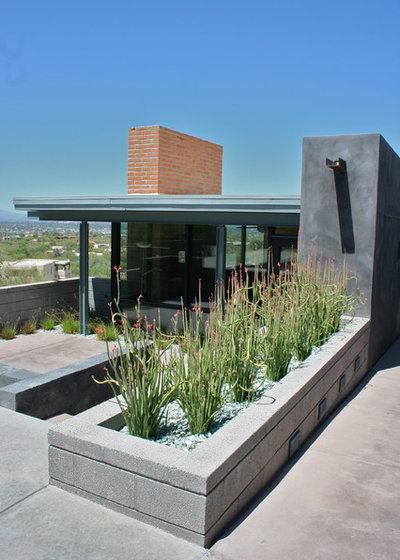
Prideaux Design
Slipper Plant (
Pedilanthus macrocarpus syn
. Euphorbia lomelii)
Slipper plant’s tapered green foliage adds sculptural interest to the garden year-round, with delicate orange blossoms appearing in late summer or fall, and sometimes also in spring.
These clumping plants can reach up to 3 to 6 feet tall and equally as wide. They prefer well-drained soil and are often seen in narrow raised beds and planters.
Bloom season: Fall
Cold tolerance: Hardy to 25 degrees Fahrenheit (zones 9 to 10)
Origin: Native to Mexican deserts
Light requirement: Full sun to light shade
Water requirement: Water monthly or as needed
When to plant: Spring or fall
See how to grow slipper plant
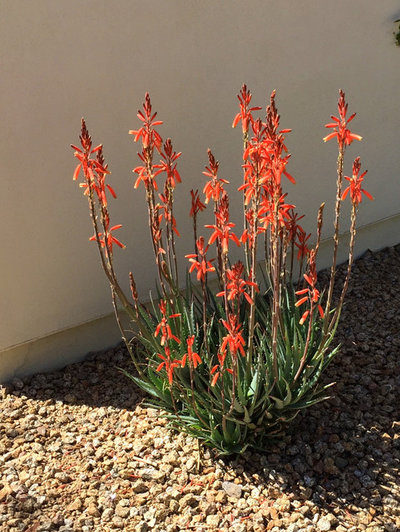
Noelle Johnson Landscape Consulting
Blue Elf Aloe (
Aloe ‘Blue Elf’)
From late winter into spring, blue elf aloe’s toothed, grayish-green foliage welcomes orange flower spikes, giving hummingbirds and gardeners something to be grateful for.
Like many succulents, Blue Elf aloe thrives in hot, reflected sun in well-drained soil. What’s unusual is that it also handles shade, through it will flower more profusely in sunnier spots.
Bloom season: Late winter into early spring
Cold tolerance: Hardy to 15 degrees Fahrenheit (zone 8)
Origin: Garden hybrid
Water requirement: Drought tolerant once established but ideally water deeply once a month in summer and once every three weeks in spring and fall; in low-desert gardens, water twice a month spring through fall
Light requirement: Full sun to light shade
When to plant: Spring or fall from division
See how to grow Blue Elf aloe
Region by region: What to Do in Your Garden This Month
See more Houzz guides to colorful flowers





